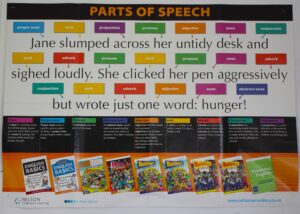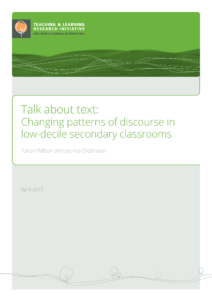Introduction
The aim of this study was to partner with six teachers to investigate and improve patterns of talk about text (TaT) in their subject-specialised classrooms. The teachers worked in two high schools in Auckland, one decile 1 and one decile 2, and taught biology, chemistry, English, health, or physical education to Year 12 or Year 13 students. The majority of students (60%–70%) were Pasifika or Māori (25%–28%). About 20% of students at one of the schools were Indian.
Together with the teachers, we found out about current patterns of TaT in the classrooms and about their and their students’ perceptions of factors that helped and hindered such talk. Then we designed and implemented new approaches and investigated the effectiveness of these.
Three key features distinguish our vision of TaT from other common forms of classroom talk. First is the prominence given to texts; in a TaT discussion, texts themselves would have a voice and be an active participant in the talk.
Second, the pattern of classroom talk known as IRE would be less dominant. IRE follows the pattern of teacher Initiates (e.g. “Who wrote 1984?”), a student Responds (“George Orwell”), teacher Evaluates (“Well done”). Rather, TaT aligns with more dialogical approaches such as “Collaborative Reasoning” (Anderson, Wilson, & Fielding, 1988) and “Accountable Talk” (Michaels, O’Connor, & Resnick, 2008) which feature more time for open-ended discussion, authentic open teacher questions which serve to explore rather than test students’ understanding, and attempts to increase ‘uptake’ whereby teachers prompt for elaboration and incorporate and build on students’ ideas (Applebee, Langer, Nystrand, & Gamoran, 2003). Our aim is that IRE is less dominant, not that it is disposed of; IRE still has an important place, for example, in helping teachers identify misunderstandings.
Third, when we talk about TaT we mean talk where ideas related to the text, rather than strategies or processes readers use to ‘get at’ those ideas, are what is foregrounded. TaT therefore is different from approaches such as Reciprocal Teaching where strategies are foregrounded and ideas backgrounded. While discussion about strategies may, and hopefully will, come up in TaT discussions, they are not the main focus.
We were interested in TaT because of its potential to improve a range of valued student outcomes including literacy, achievement, and affective outcomes. The need to improve these outcomes is pressing in lowdecile schools situated within a national educational context characterised as high quality but low equity. Secondary students, particularly those in their senior years, need high levels of literacy to comprehend and create increasingly sophisticated and subject-specialised texts (Shanahan & Shanahan, 2012). Internationally, extended discussion or dialogic approaches have been promoted as a means of helping students learn through and about texts (Wilkinson & Son, 2009). It is thought that participating in rich disciplinary talk about rich disciplinary texts will at once help ‘apprentice’ students into a particular discourse community and change that discourse community by inviting new voices and perspectives (Moje, 2008). From a dialogic perspective it is from interaction and negotiation among different voices that meaning and understanding emerge.
Dialogic approaches have been associated with a range of positive outcomes for students including improvements in reading comprehension (Wilkinson & Son, 2009), writing (Jesson, McNaughton, & Parr, 2011), understanding of curriculum content (Hennessy, Warwick, & Mercer, 2011), and affective outcomes, including feeling more confident and valued as members of the classroom community. The authors of a previous TLRI project found that collaborative discussion was not only associated with improved levels of mathematics achievement for primary-aged Māori and Pasifika students but also helped them form, “powerful dispositions to do mathematics and to think of themselves as mathematicians” (Hunter & Anthony, 2011, p.5). Despite the benefits of discussion identified in this growing knowledge base, recent evidence from New Zealand (Wilson, Madjar, & McNaughton, 2016; Wilson, McNaughton, & Zhu, 2017) showed Year 12 students in English, mathematics, and science classes in low- to mid-decile schools had few opportunities to engage in rich talk or to read rich texts, and fewer opportunities still to engage in rich talk about rich text. Internationally, previous studies have found that teachers find it very difficult to change classroom discourse patterns, even when they want to (Alozie, Moje, & Krajcik, 2010; Groenke, 2010).
Research design and methods
The first year of the project was a profiling phase in which the teachers and researchers worked together to find out about patterns of TaT in the classrooms and about teachers’ and students’ perceptions of TaT. The key measures used were interviews with teachers and students, a student questionnaire, observations of TaT discussions, and analyses of historic patterns in the National Certificate of Educational Achievement (NCEA). The data analysed in the profiling phase served two key purposes. Firstly, they gave us a rich picture of TaT that we could use to design new approaches tailored to the local classroom contexts. Secondly, they were a baseline measure we could use later to evaluate the impact of the new approaches.
All measures were repeated at the beginning and end of each year. In total, over the four time points, we collected and analysed interview data from six teachers and 49 students, 302 student questionnaires, and 48 discussions of about 20 minutes each. Discussions were audio-recorded, transcribed, and analysed qualitatively and quantitatively using indicators such as the balance of student to teacher talk, the length of teacher and student utterances, the frequency of authentic teacher questioning and uptake, and the extent to which texts were employed as a participant in the discussion.
The second phase, which lasted throughout 2016, consisted of ongoing professional learning and support for the teachers as they worked to change patterns of TaT using collaboratively designed approaches, and repeated measures.
What we found out in the profiling year
Teachers’ and students’ beliefs about the value of TaT
It was clear at the beginning of the project that students and teachers already highly valued the potential of classrooms discussions for developing students’ understanding, building relationships, and for sharing different perspectives on subject-related content. However, students and teachers did not talk much about the value of discussion as a means by which students could develop deeper understanding of texts or improve their subject-area reading more generally.
Students valued discussion for the opportunities it gave them to listen to different perspectives on a particular topic:
You get like five other people who say totally different things. Yeah, it’s really cool when you are listening to them and you think, “Oh, why didn’t I think of this before?”
We are all speaking up to each other and can learn from their perspective as much as they can learn from mine. We are all communicating and learning with each other which makes it good.
Teachers also valued the perspective-sharing aspect of discussions but saw more generalisable benefits of this for building students’ empathy:
I think the bigger thing I want the kids to get out of group discussion is a different point of view and just those things like empathy. (Health)
Trying to see if they had any thoughts or ideas that were different from each other’s and trying to get them to think about being in someone else’s position or seeing it from another point of view. (English)
Teachers also valued discussions for the vital diagnostic and formative information they could provide about students’ learning:
(I use discussion) to look at their prior knowledge and see what they actually know, to see if they are on the right track. (Health)
I’ll use a group discussion as a sort of a formative tool to see how they’re going with the work at hand or what they think about it. (Chemistry)
Students and teachers both reported that a key affordance of discussion was that students could hear new ideas and concepts expressed by peers in ‘student-speak’. Teachers noted that:
They like hearing their friends talk about stuff because it’s in their language then and they do take confidence from each other. (Chemistry)
Discussions are good because if they are hearing their peers describe ideas in their own words then I think it is really beneficial. (Biology)
And students said:
Sometimes even the teacher doesn’t answer it, it’s the student and it’s more relatable to you when you hear from someone that is close to your age.
If someone does have another idea about how to get the answer we will definitely hear their point of view because it is most of the time better for us to hear it from a student’s perspective rather than a teacher(’s).
I think it is the way us students put it, it is different, you know how you read something and then you kind of understand it but then when someone else says it, it is in a different way but explained better for you.
Yeah hey the part about the blood I didn’t even get it, but listening to other people talking about it I was like, “Oh yeah, I get it now, I get the meaning of it.”
To investigate what TaT was actually like in practice we conducted classroom observations. Some key findings from the first round of these are summarised below.
Analysis of TaT discussions
At four time points across the project, teachers were asked to facilitate two TaT discussions of about 20 minutes each. In the first round of observations we recorded one whole-class and one small-group (four to six students) discussion. The discussions were audio-recorded, transcribed, and entered into a database. The database consisted of one row for each utterance in the discussion. An utterance began when that participant began speaking and ended when another speaker began speaking or the discussion came to an end. We coded each utterance according to whether it was spoken by the teacher or a student, and the number of words it contained. Teacher utterances were coded for features such as if they included a question and, if so, whether or not the question was one that could be answered in one or two words, if it was a question requiring an opinion, and if it explicitly asked students to draw on out-of-school knowledge including linguistic or cultural knowledge. Students’ responses were classified for features such as if it was unelaborated (typically one- or two-word responses; most often “yes” or “no”) or elaborated (including examples, reasons, explanation). Teacher and student utterances were also coded according to whether there was any direct reference made to the text or texts. Quantitative analyses were of the length of utterance (number of words) and frequency with which particular features were observed.
Visual representations of some of these profiling analyses are included as ‘Time 1’ data in the ‘Evidence of shifts’ section of this report. The key patterns of TaT that emerged in the profiling phase were:
- The discussions tended to be teacher dominated. The average teacher utterance, for example, had 34 words whereas the average student utterance had five words.
- A high proportion (46%) of the questions teachers asked required just one or two words to answer. Of all teacher questions, 4% asked about students’ opinions.
- Students’ responses were more often unelaborated (84%) than elaborated. Students made a direct reference to the text in 15% of their utterances.
- Teachers did regularly ask students to elaborate on their responses (31% of all utterances) but there were very few instances (9%) where the teachers asked specifically that students refer to the text.
Having identified patterns in TaT, we wanted to investigate what teachers and students saw as barriers and enablers of productive TaT.
Factors that help and hinder TaT
Shyness
The most common barrier teachers and students identified in the interviews was many students’ reluctance to speak because of a lack of confidence that was mostly related to shyness and/or a fear of being “wrong”.
Teachers said:
They are shy because they do lack confidence this class. As a whole, they do lack confidence. (Biology) It’s a huge confidence thing. (English)
Our kids are really terrified of failing. They are not willing to take the risk to be wrong because then they are doing it in front of their teacher so their teacher knows. (Health)
Nearly half of the students interviewed described themselves as “shy” or “unconfident” in speaking in wholeclass discussions. Many said that they often wanted to contribute but “held back” from doing so because of shyness. Most students reported that they were much more likely to contribute to a discussion if it was in a small group:
I talk more in a smaller group. Like sometimes I feel embarrassed if I say something and it’s wrong. Sometimes (in a whole-class discussion) I’ll have the right ideas and then someone else will say it and I’m like, “Oh, I should have just said it myself.”
In a smaller group I feel like I am more of a speaker … I speak more confidently in a (smaller) group.
I reckon more ideas actually get said (in a small group) and sometimes in the whole class you kind of don’t want to say your idea out (loud) because of how many people (there are).
Fear of being “wrong”
Implicit in these responses, and those below, is that students typically viewed discussions more as an opportunity to showcase existing knowledge than an opportunity to build new knowledge:
Sometimes you just talk back the answers too scared of saying a dumb answer.
I am more of a listening person, but I do raise my hand when I do know something.
Sometimes, you don’t know what you are saying is actually what we are talking about or if it’s wrong and keep to yourself. I think those things scare some people.
The corollary to some students being reluctant to participate was that students perceived whole-class discussions as often being dominated by a small number of students:
So we have the same people answering most of the time. Miss tries to change it up by asking people that don’t answer much but they are really quiet.
This was echoed by teachers:
Whole-class discussions can turn into a bit of like a three- or four-man show while the rest of the class just sort of sit back. (English)
It gets dominated by one or two individuals. (Physical education)
Classroom environment
Students and teachers were both concerned about the potential for off-task behaviour in discussions that could make it unsafe for students to share ideas. Several students said that a major barrier to their contributing to a discussion was when other students did not listen to them:
If people aren’t listening, it makes it hard because then you have to repeat it if you want to be heard. It is like, “Oh, no one cares about my opinion.”
More concerning though was the many more students who reported that they or their peers refrained from speaking because of a fear of being judged or even “mocked” by their peers. Although one student acknowledged that he would be reluctant to share a “really smart idea” for fear of mocking, students were much more often concerned about saying something “dumb”, “wrong”, or that “missed the point” of the teacher’s question:
Some people mock you with the answer you give.
Everyone is too scared (that) their answers are probably wrong … it’s just embarrassment… I’m not the only student but I have other kids tell me that they just feel intimidated by people from levels more higher than they are.
Some people think others would judge them depending on their opinions or even mock them.
There’re people in the class that just don’t take it seriously and (you) kind of get put off by the idea of talking and they want to comment on yours and it’s a put-off.
Teachers also saw inappropriate student behaviour as a risk in discussions:
As a large group, the class becomes harder to manage because it’s easier for individuals to derail the process. (Chemistry)
When they get together as a group they automatically go off task. If they are a group of friends they automatically talk about something else. (English)
When it does occur and there are put downs. How do you deal with that in the middle of that discussion? You don’t want to deal with it publicly, but you are in the middle of a public discussion so you do have to deal with it publicly. (English)
Empathy
Despite describing environments where classroom talk was sometimes constrained by the behaviour of their peers, a striking feature of the interviews was the high level of empathy expressed by those students who selfidentified as confident participants in discussion for classmates who were not:
Maybe teachers could stick to small-class discussions (because) those that don’t really understand are probably too scared to speak up or say anything during whole-class discussion and when she (teacher) went and spoke to them individually with their group they are comfortable with that. They probably won’t all understand but they can help each other out.
I got to help one of the brothers out into solving something he didn’t understand because he might be shy in a bigger group than he is in a smaller group. I found out that he kept on asking more questions in the small groups than he did in the larger groups.
Yeah, some of us are from the islands and because it is hard just to take another language in and maybe they (more recent migrants) have something to say but they just don’t know how to put it and they don’t want to say it just in case they get mocked for it.
Note, too, how many of the student quotations here and throughout the report use inclusive first-person pronouns such as “we” and “our” and “us” to describe the affordances and challenges of class talk.
Benefits of small groups
In terms of overcoming the barriers outlined above, teachers saw benefits for small-group discussions, particularly in terms of giving students more confidence to participate:
It’s easier for students to participate if it’s a small group … it’s less of a risk for them. (Biology)
Small-group discussions benefit the shy person because it is only a few so they will be happy to speak in that small group. (Chemistry)
The kids feel just a little bit more confident to speak and share and participate; it’s not as daunting as you and 25 other kids. (English)
However, students and teachers both told us that when students did have small-group discussions, the teacher typically roved around the different groups without spending an extended period of time in any one discussion:
I don’t like to mandate it because I would just rather it happen naturally. (English)
If I’m moving around the class and I’m noticing students having a particular problem it’s really easy at that point to stop everyone and have a discussion about what is going on to make sure everyone is at the right level with whatever we are working on for that day. The discussions will probably be a few minutes at most. (Chemistry)
Students though saw the benefits of having teachers taking a more active role in small-group discussions:
As long as the teacher is around, the students are actually more willing to actually give their input on it. Sometimes the students will sit to the side and not say anything until the teacher actually asks for their input on it.
It’s hard to keep speaking if they (teacher) are just not even in the conversation at all, like they are off doing something else like doing work or something at the back of the room.
Importantly, students, including those who preferred small-class discussions, saw potential benefits in wholeclass discussions:
I also see perspectives on the other students as well. Like working in a small group is good for my confidence, but it is working in a larger group that helps us come up with ideas that maybe we haven’t discussed in the group.
I like whole-class discussions because everyone has different ideas and they combine more information.
Profiling summary
In the profiling phase we identified key strengths we could build on in the next phase. We clearly did not have to put effort into convincing teachers and students that developing rich talk was a worthwhile goal. But we did want to extend what they valued about discussion to include benefits for engaging with texts in particular and for developing reading more generally. Teachers did not need any encouragement to see increased student participation in discussion as a good thing. But there was a need to develop more strategies for achieving this in practice and for extending teachers’ notions of who was a participant in discussion to include the texts themselves. Students already saw talk as helpful for developing understanding of concepts and hearing other perspectives. But it was clear that students mostly saw classroom discussions more as ‘tests’ or ‘performance pieces’ than as opportunities to take risks and socialise partly formed ideas as a means of developing new understandings. As well as the high value students and teachers already afforded classroom talk as a learning tool, another key enabler was the high levels of student empathy that came through so strongly in the student interviews. Also, while not widely used, the profiling also identified teacher-facilitated small-group discussions as a potentially powerful structure for facilitating more productive TaT.
Designing a response
Our approach for supporting changes in TaT practices had three key components: a research and data focus, a student focus, and a teacher practice focus.
First, the teachers and researchers worked together to understand all the data that had been collected. Activities went beyond the researchers simply presenting the results of our analyses back to teachers. For example, teachers in pairs were presented with transcripts from their own discussions, coded these together, and reported back key patterns to the rest of the group.
Second, we developed tools that we hoped would involve students more in decision making about next steps for TaT. These included a presentation for students (https://docs.google.com/presentation/d/156Gg4sjfU_RW GvBdca8l2Z5M_2SDRKpZqCzPQnGBmdo/edit?usp=sharing) explaining the project and theoretical rationale for it, and tools where students could suggest ideas for classroom protocols and about the wording of teacher and student “talk moves” (Michaels & O’Connor, 2012), and reflect on why such protocols and talk moves might be useful (https://docs.google.com/document/d/1AvB92ErtNg6s0EQZkSZpuGAaC0zf7_GjmtGa3RwZqGk/ edit?usp=sharing). This, like the questionnaires and interviews with students, aimed to make students more than passive beneficiaries of a research and development project done on their behalf but without their voice.
Third, we designed a generic structure to help teachers plan a series of lessons that would culminate in a series of TaT discussions with small groups (https://docs.google.com/document/d/13fu02zZ19otydReC5aGRzIQhveWk A4d79XhLEsOLDnU/edit?usp=sharing).
We decided, with our colleague Rebecca Jesson, to frame all of our discussions around a text set made up of two or three texts based around the same topic. We identified four types of texts that could comprise a text set:
- Scaffolding text. This would be an accessible-level text that students could read independently. This text would introduce some of the ideas and vocabulary that students would encounter in a more complex form in other texts. The idea is that this text or texts would act as the scaffold—as well as or rather than the teacher.
- Complementary text. This would offer content or perspectives consistent with those of other texts but with more information or additional examples.
- Tension text. This offers a different point of view, conflicting information, or a counter argument. The role of this type of text in a text set is to create some tension or ambiguity that students need to resolve.
- Student-selected text. This is a text that a student would source independently. The purpose of this was to develop students’ strategies for independent text selection, vitally important for students soon to leave high school, and to provide opportunities for students to access texts that link to their interests and out-ofschool knowledge.
In our research and development sessions with teachers we helped one another assemble text sets and workshopped ideas for preparing students to read the texts and to engage in small-group discussion. These included prior-knowledge activities and activities that would support students to come to the small-group discussion having read the texts and with some understanding of them.
We agreed that each round of TaT would culminate in a series of discussions with small groups over two or three periods. The teacher would be an active participant throughout each group’s discussion. This meant teachers had to decide how to group students, how they would rotate through groups (e.g. if a class was split into four groups, they might run two 20-minute discussions per lesson over two lessons), and what learning activities other students could be engaged in. We agreed that two rounds of talk per term was a manageable amount and would minimise the opportunity cost for students in terms of the time they could not access their teacher while he or she was facilitating talk with another group. The shift to small groups was quite a radical shift for secondary teachers; although primary teachers are very used to using such groupings (e.g. for guided reading) this is not a common feature of secondary pedagogy.
Evidence of shift
Our analyses of classroom talk at four times over 2 years showed some key shifts in TaT patterns. Firstly, students at the end of the project spoke more in the discussions than they had at the beginning (Figure 1). While teacher utterances were still generally longer than students’, the balance of student–teacher talk had improved quite markedly.
FIGURE 1. Length of student and teacher utterance by time point
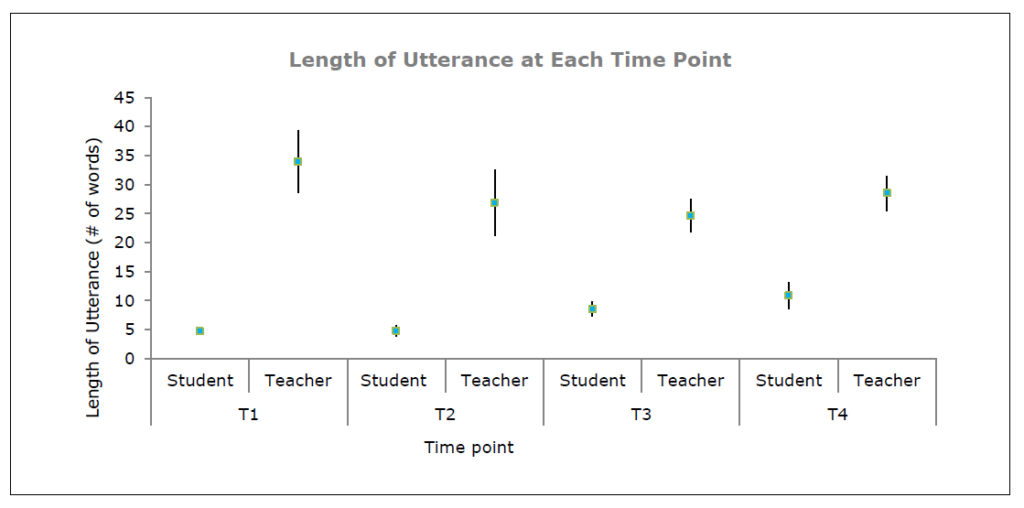
There were also shifts in the types of questions that teachers asked (Figure 2). At the beginning of the project there were relatively more questions answerable in one or two words. By the end of the project the proportion of questions requiring longer answers had increased.
FIGURE 2. Types of teacher question by time point
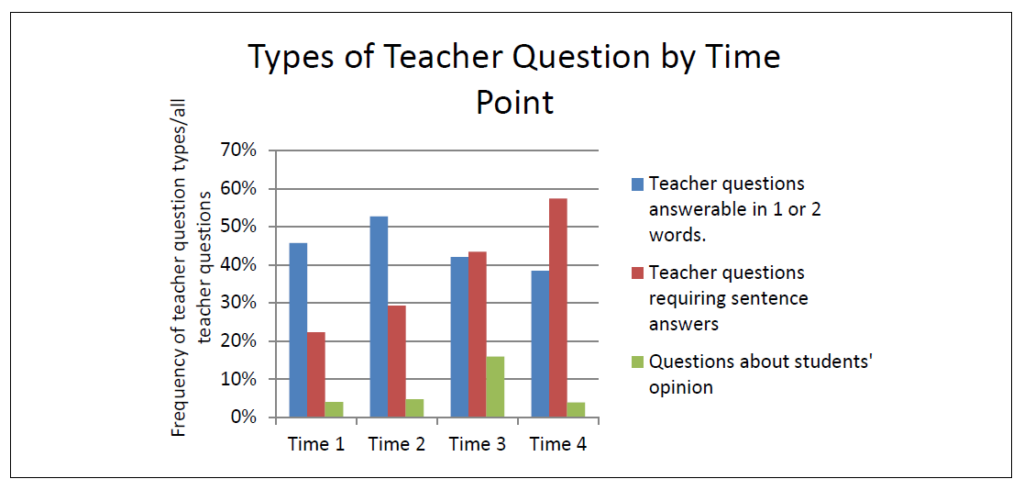
Two very important shifts in the way that teachers responded to students’ ideas were evident. Firstly, teachers at the end of the project were much more likely to prompt another student to build on the previous student’s contribution. Secondly, the teacher was much more likely to prompt the students to refer directly to the text.
FIGURE 3. Types of teacher prompt by time point
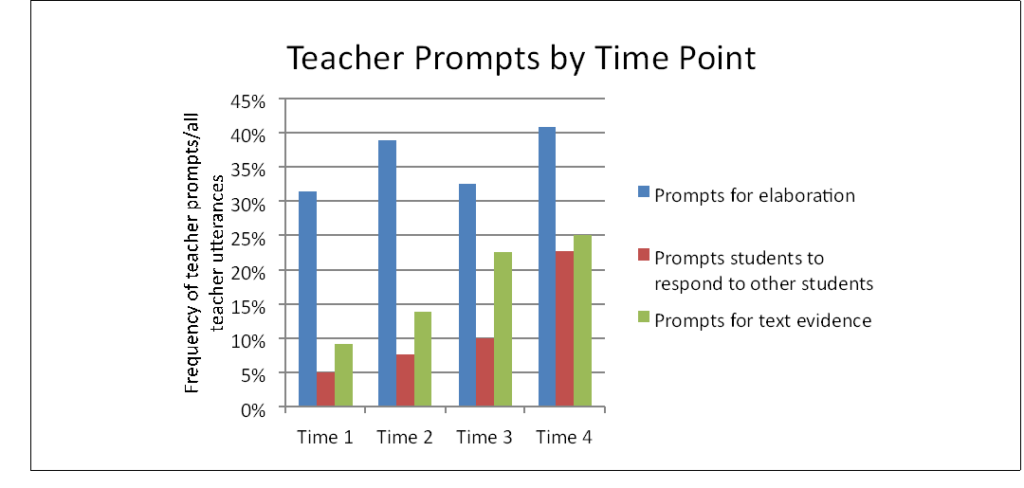
FIGURE 4. Types of student response by time point
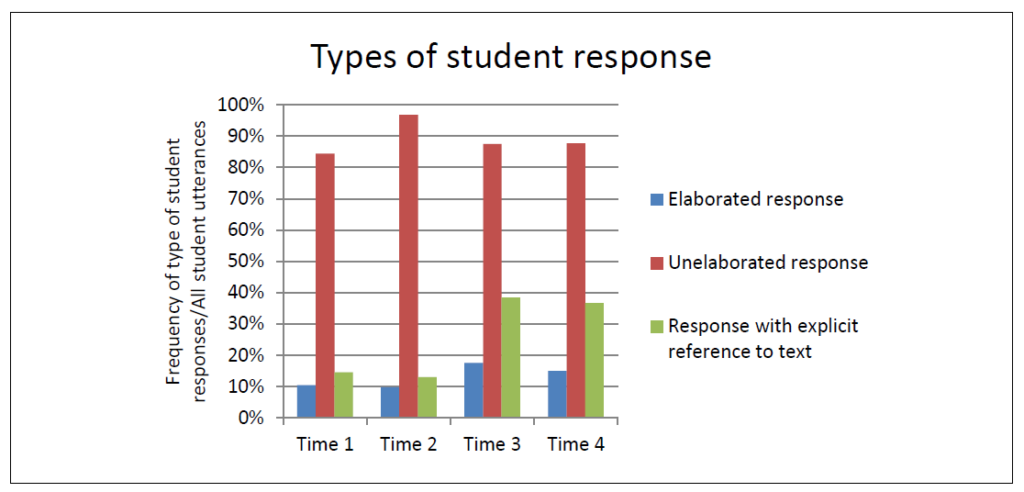
Two major shifts were evident from our analysis of students’ utterances. Firstly, the proportion of student responses that were elaborated responses had increased from 10% at each of the first two time points to 18% and 15% at times 3 and 4 respectively. Secondly, and perhaps most importantly of all, was the very marked increase in the number of references that students made to the texts.
FIGURE 5. Patterns of turn-taking and utterance length at Time 1
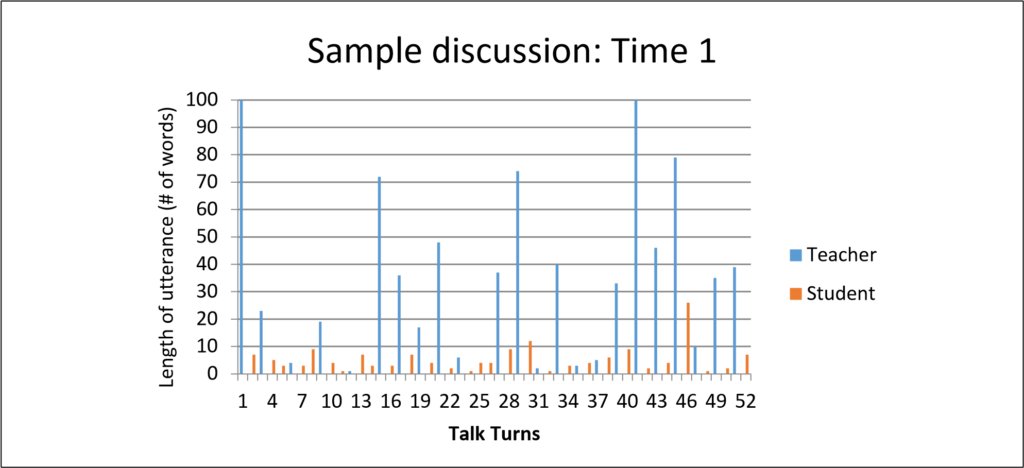
Each point in the x-axis (horizontal) represents one utterance; teacher utterances are blue and student utterances are orange. The height of the line shows the number of words that each utterance consisted of. The first thing to note is how much longer the teacher utterances are than student utterances. The second thing to note is how the turn-taking pattern is mainly teacher–student–teacher; there are few cases where a student responded to or added to something another student had said without the teacher responding first.
Figure 6. Patterns of turn-taking and utterance length at Time 4
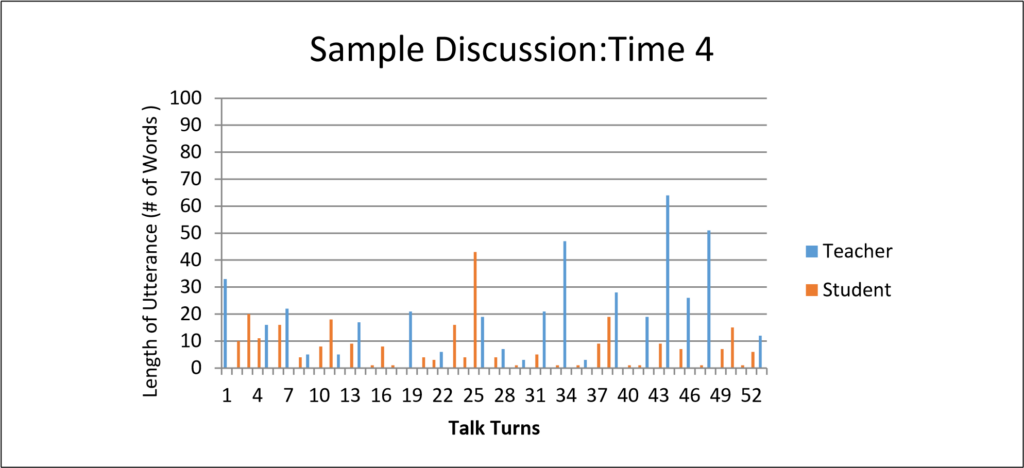
Two key shifts are evident when we compare the Time 4 discussion to the Time 1 discussion. Firstly, note that the teacher and student utterances were now much closer in length; the teacher was talking less and the students were talking more. Secondly, note how much more frequently one student will follow on from another student’s response without it going back to the teacher as it did so often at Time 1.
Teachers’ and students’ perception of shifts
All the teachers reported that they were more frequently having structured, teacher-facilitated small-group TaT sessions. All teachers were positive about the benefits of these:
I’m doing more than previous years. I think the small group is a lot more effective. Whole class is all good, like we talk, but it only goes to a certain level. I’ve opted for smaller group discussions this year, especially since being part of the research. (English)
I definitely found I’ve had way more discussions this year. (Health)
Whole-class discussions probably remained quite constant with previous years, but I have tried to do more activities which lend themselves to small-group discussion. (Chemistry)
I have done it a lot more this year. I’ve done it and it has worked for me. (Biology)
Students at the end of the second year had noticed that the teachers had had an increased focus on discussions and were trying to change:
It was like she was trying more because she is having more whole-class discussions and group discussions. She is trying to make us talk and not her saying much.
She has been telling us to talk more and get ideas of what else someone is saying. She has been telling us to do that a lot.
Now he always asks like “Why?” and so you give an answer and he’ll be like, “Why? Elaborate on it. Be more specific.”
Students were all positive about the value that teachers could add to small-group TaT discussions:
I like the small discussions when the teacher is present. So like if she made us all do little group discussions I think a lot of us would get carried away and she won’t be able to have time to go through every group.
I think because she asks the questions and then we actually think about it. Like she asks pretty deep questions and then we will think about it.
All of the teachers also reported that they had placed an increased focus on reading:
It’s made me think about how much reading my students actually do … it’s made me introduce more reading to my students and use activities that involve reading … There wouldn’t be too much specific reading time in my chem. class prior to doing this. There’s been more reading in my class than there has been, than ever. (Chemistry)
I’ve increased the number of talk moves and I’ve increased the number of texts. (English)
“This is what we’re doing, ok. You are going to be involved in this. It’s an expectation. No one has a get out of jail free card with this, you are all doing it.” Just to give them prior warning so that they take the readings seriously. (Health)
Teachers reported using texts more often for “reading to learn” purposes; that is, tasks where students would learn ideas from text rather than from their teacher:
(Previously) I would have taken that two-page reading on the New Zealand land wars (background information for a poem) … What I would have done is just read the two pages and then tried to make bullet points you know. Like five slides, four bullet points on each. (English)
It’s been useful in terms of me getting away from PowerPoints and teacher blah blah at the front of the room. (Chemistry)
Telling them what to learn and giving them that knowledge, it’s giving them the fish. It’s only ever going to be helpful for that instance. But teaching how to fish and teaching them how to find this information and what’s a credible resource and what’s not, and where to look, and looking at both sides of things, is teaching them how to fish and that will give them the skill that they’ll need forever. (Health)
So I felt for the first time, well not for the first time, but I felt like they were starting to create their own understanding without me having to do that for them. (Chemistry)
Some teachers also reported that they had used more complex texts with their students:
(Whereas previously when he used a challenging text he had) scaled it down a bit for them, this year I actually did not scale it down for them… I wouldn’t say I treated them as uni students but I actually gave them a very high-level type of text. (Biology)
One of the biggest changes in our reading in my class is that we actually read, so for (achievement standard) 2.1, the written text I chose to do was a novel and it’s the first time I’ve done that. Conventional wisdom is, “don’t do a novel because it’s hard to get them to read it”, so you would teach a poem because you can make sure everyone reads it inside five minutes (but) I was like, “I’ll take the challenge” and it worked really well, like everyone read the whole book. Some of the kids said to me, “You know Sir, this is the first book I’ve ever read.” And that was pretty awesome. (English)
References to reading and to texts, which had largely been absent in our interviews with students at the beginning of the project, were mentioned much more regularly at the end of the project:
Most (English) teachers (in previous years) would do movies instead of books and it would be easier for students. Mostly the students here wouldn’t read and take the easy way out and just watch the movie.
(Without having read a text) you’ve got nothing to sink your teeth into because you haven’t come with anything.
You can’t really answer questions about a text if you haven’t read it. It creates discussion. It opens up more perspectives and gives you different ideas. You read it, you interpret it in your own way, and then like it might be different from how someone else does. I think like a mixture of ideas (from texts and discussion) helps you counter your own sometimes. So it just prompts thoughts.
Teachers found that using text sets had rewards:
(Using three texts meant) there was some deep thinking required to even piece these three things together … just by the nature of the texts that we used, students had to operate at a deeper level. (English)
It is more interesting for me to see the students use those two different texts about the same new topic to start to create their own understanding without me having to simplify the textbook for them or simplify their ideas. (Biology)
I could bring in two polarising articles that gave two totally different opinions of things and the kids are like, wow this is the same topic but (the writers of the texts) feel really differently about it and you can sit anywhere along that line but you have to say why you are there and you think that perhaps this argument isn’t balanced so that whole reasoning was brought. (Health)
However, using text sets also presented its own challenges:
I had the problem of how am I going to get through these three text sets? Do I use my double period in the two hours to go through them and give them an activity after each one so I understand that they know what the concepts are and things like that? With some of my Year 13s that is just not possible. (Health)
I had issues with how long (the reading would take). Like I don’t think I’d actually have time to have them read this, read that and think about the film and discuss it all. (English)
Students found text sets challenging but ultimately of value:
I reckon it was like when I saw three texts and I thought it was a bit too much but then we read through all of it. I reckon it was better that way because it gave us more information about the subject we are talking about, and it gave us a better understanding.
I reckon it was more helpful; it is just when it comes to poetry a lot of us start to struggle because poetry is just weird … it’s not very straightforward. He gave them (texts about the historical background and the poet Sam Hunt) to us and told us to read it.
Reading a text set that required students to link biological knowledge to real-life contexts was useful because, “it shows us that biology isn’t just GE, and tides and double stranded helix DNA, RNA”.
One aspect of the TaT partnership that teachers found useful was the use of evidence and data that helped them reflect on their own TaT practices. All of the teachers found that the research and data aspects of the project had given them an objective, and often challenging, picture of TaT patterns in their own classrooms:
The data stuff has been fascinating … we’re in a unique position in that we’ve someone come and look at what we’ve done in the classroom and then a few weeks later gone, “Here it is. This is your transcript this is the data broken down.” (Chemistry)
You can’t hide from it and be like, “Oh my perception of the way it was, was this.” When you look at the data it’s confronting but in a good way. (English)
What set the alarm bells off for me was the transcript that I got back. It gave me the shock of my life to listen and to read … I don’t think I would have felt that way if I hadn’t seen the graph that showed this many open questions that many closed. That was useful data to see. It’s confronting data to see. (Biology)
It’s not like a criticism, it’s just what you did and if you don’t think it’s right, then that’s on you. It’d be harder to take if it was just someone listening to you and then saying, “Oh nah, nah. You did too much talking.” (English)
(The data feedback was useful because) We’re islands. We teach in isolation. We don’t have people going, “You talked a lot today and the kids didn’t talk much. You might want to think about that.” (Health)
Were there NCEA outcomes associated with TaT?
In partnership with the teachers, we identified achievement standards that met our criteria for being sensitive indicators of students’ subject-area literacy. We calculated the percentage of TaT students achieving (at Achieved, Merit, and Excellence level) as different from the national norm because the standardised nature of NCEA means that different standards have a different national norm within the same year and the norm for the same standard is different over different years. Having a standard score allowed us to make comparisons within and across years. The mean difference from norm was calculated for as many previous years as there were data available for that standard. In the case of chemistry and health, all students in the schools’ data were TaT students (as only one class in that subject was taught at that level). In biology and English, however, students in other classes also attempted the same standards and it was possible to make limited comparisons between TaT and non-TaT students within the same school.
FIGURE 7. Achievement rates in indicator of NCEA achievement standards
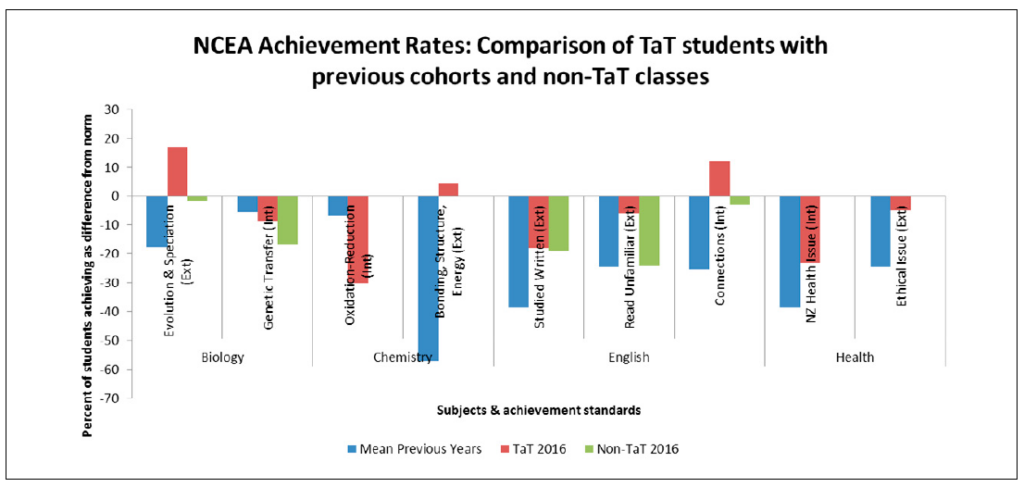
There is evidence of overall improvements in students’ NCEA achievement in TaT classes relative to national norms. Within schools, TaT students outperformed non-TaT students in all five indicator standards offered in English and biology. For seven of the nine indicator standards, TaT students’ achievement rate was higher than the mean achievement rate for students in previous cohorts from the same schools. Note that achievement rates in all five externally assessed standards had improved. This is particularly important given that developing strong independent readers and writers was a valued outcome of TaT.
For the analyses shown in Figure 7 we followed the New Zealand Qualifications Authority (NZQA) practice of calculating achievement rates as a percentage of all students who attempted the standards; that is, excluding students who had been entered for the standards but were absent (ABS) for the external assessment and those who were present but chose for whatever reason not to attempt it (SNA). We were interested, however, in whether the ABS or SNA rate would be different for TaT students, so we compared these to the rates for nonTaT students in the two subjects we were able to: biology (Figure 8) and English (Figure 9).
FIGURE 8. Comparison of TaT and non-TaT pass, endorsement, and attempt rates for 2016 biology
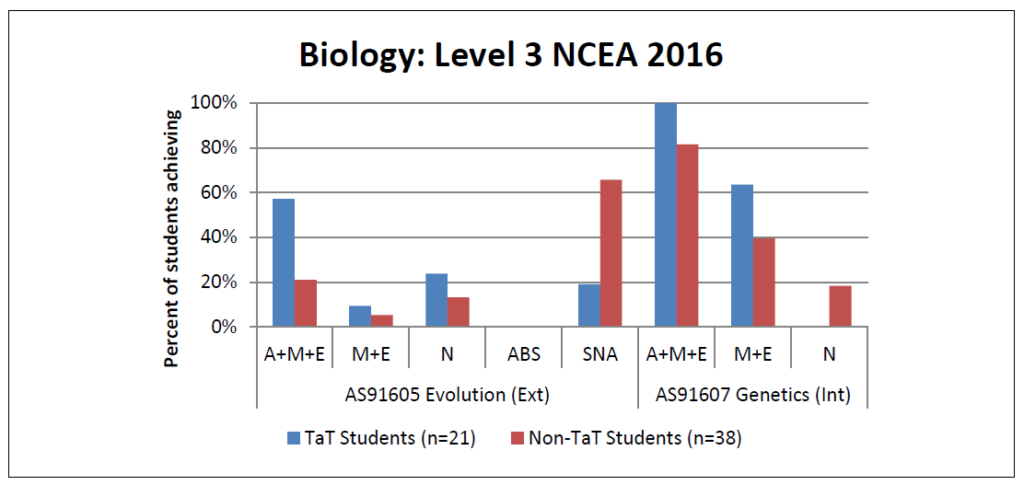
FIGURE 9. Comparison of TaT and non-TaT pass, endorsement, and attempt rates for 2016 English
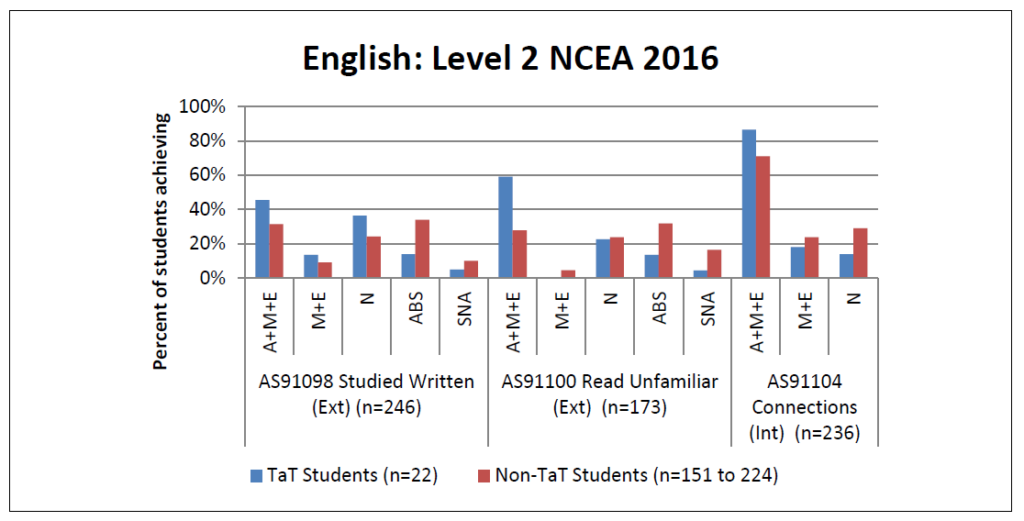
Students in TaT classes were quite markedly more likely to attend the external assessments and to attempt the standards if they did attend. Note that about 65% of non-TaT students did not attempt the Evolution external standard, but only 20% of TaT students did not. The higher rate of attempting the standard likely explains the higher Not Achieved rate for TaT students (21%) compared to non-TaT students (12%). A similar pattern is evident in English where the combined ABS/SNA rate for the two externally assessed standards was less than half that of non-TaT students.
In summary, the analysis of 2016 NCEA data provides qualified support for the claim that TaT was associated with achievement rates that were higher than that of past cohorts and, in the case of English and biology, higher than that of non-TaT classes. Also of interest is the markedly higher rate of attendance and completion of externally assessed standards for TaT compared to non-TaT students. Although this phenomenon requires more investigation, we wonder, too, if there were affective outcomes associated with TaT, such as resiliency and self-efficacy, that may have contributed to this interesting and promising pattern.
Limitations
The situated nature of our study limits the generalisability of our findings and the extent to which the TaT approach we designed for a specific context could be implemented without significant modification in other contexts. An underlying assumption of the project was that local interventions are most effective when they are designed using local evidence and are tailored to the local context. Although we suspect that we would find similar patterns of TaT and text use if we conducted similar profiling in other low-decile secondary schools, we do not know this for sure. Even if the patterns were similar, we do not know whether the same factors would be what helped or hindered TaT in those other settings.
Implications and recommendations
This study has confirmed for us that our goal of promoting richer talk about richer texts is a worthwhile goal. We see the positive response of teachers and students to the TaT approach, the changes in patterns of talk, and the increased prominence of texts in the classrooms as important outcomes in themselves. We are confident, too, that these participatory and affective outcomes did not come at the expense of achievement in NCEA. TaT students’ achievement in the indicator standards was in most cases higher than previous cohorts and nonTaT students from the same schools. This is important because one of the most common reasons secondary teachers have shared with us for limiting students’ opportunities to learn from text and engage in discussions about text is that more direct forms of teaching are more efficient ways of disseminating subject content. The teachers did not stop using more direct forms of teaching but they did balance these more with activities where students learnt from text and TaT. This rebalancing did not have reduced NCEA student achievement as an opportunity cost. Despite a need for further studies that more systematically test its effectiveness, the evidence we have is that TaT is a promising instructional approach.
One component of the approach we designed that we think might be more widely applicable is the teacherfacilitated small-group TaT format. The strong and almost universal agreement of the students that smallgroup discussions provided a better environment for rich TaT suggests to us that this might well be the case in other schools. While introducing our small-group approach can be a significant shift for secondary teachers, and requires careful planning, we certainly think it is worth trialling. As well as the benefits noted by students, teachers found the small-group format to provide a safer space for their trialling and refining of TaT facilitation strategies, such as questioning, prompting, redirecting, and waiting. It is important to note though that smallgroup discussions are no silver bullet. In the first round of observations, teachers recorded one whole-class and one small-group discussion; at that stage there was no difference in the relative participation of students in the different formats. We also think that teachers should consider more often including text sets as part of their teaching repertoire. As noted above, how these would most effectively be implemented in other contexts would depend on what the local profiling showed up.
While we are not sure how much of the TaT ‘product’ could be applied to other contexts, we are confident that aspects of the ‘process’ could be. In particular, this study confirms for us the importance of including a detailed profiling phase. We highly recommend that people wishing to change TaT patterns spend time analysing and discussing data about current patterns of classroom talk. The teachers found the sharing of observation data that highlighted gaps between their perceived and desired TaT practice to be one of the most powerful aspects of the project. We also recommend that teachers spend time talking with the students. We hope that it is very clear from this report that what the students contributed was insightful and invaluable.
References
Alozie, N. M., Moje, E. B., & Krajcik, J. S. (2010). An analysis of the supports and constraints for scientific discussion in high school project-based science. Science Education, 94(3), 395–427.
Anderson, R. C., Wilson, P. T., & Fielding, L. G. (1988). Growth in reading and how children spend their time outside of school. Reading Research Quarterly, 285-303.
Applebee, A. N., Langer, J. A., Nystrand, M., & Gamoran, A. (2003). Discussion-based approaches to developing understanding: Classroom instruction and student performance in middle and high school English. American Educational Research Journal, 40(3), 685–730.
Groenke, S. (2010). Missed opportunities, misunderstandings, and misgivings: A case study analysis of three beginning English teachers’ attempts at authentic discussion with adolescents in a synchronous CMC environment. Journal of Technology and Teacher Education, 18(3), 387–414.
Hennessy, S., Warwick, P., & Mercer, N. (2011). A dialogic inquiry approach to working with teachers in developing classroom dialogue. Teachers College Record, 113(9), 1906–1959.
Hunter, R., & Anthony, G. (2011). Learning to “friendly argue” in a community of mathematical inquiry. Wellington: Teaching and Learning Research Initiative.
Jesson, R., McNaughton, S., & Parr, J. M. (2011). Drawing on intertextuality in culturally diverse classrooms: Implications for transfer of literacy knowledge. English Teaching: Practice and Critique, 10(2), 65–77.
Michaels, S., & O’Connor, C. (2012). Talk science primer. Cambridge, MA: TERC. Available at http://inquiryproject. terc. edu/shared/pd/ TalkScience_Primer. pdf
Michaels, S., O’Connor, C., & Resnick, L. B. (2008). Deliberative discourse idealized and realized: Accountable talk in the classroom and in civic life. Studies in philosophy and education, 27(4), 283-297.
Moje, E. (2008). Foregrounding the disciplines in secondary literacy teaching and learning: A call for change. Journal of Adolescent & Adult Literacy, 52(2), 96–107.
Shanahan, T., & Shanahan, C. (2012). What is disciplinary literacy and why does it matter? Topics in Language Disorders, 32(1), 7. doi:10.1097/TLD.0b013e318244557a
Wilkinson, I. A., & Son, E. H. (2009). A dialogic turn in research on learning and teaching to comprehend. Handbook of Reading Research, 359.
Wilson, A., Madjar, I., & McNaughton, S. (2016). Opportunity to learn about disciplinary literacy in senior secondary English classrooms in New Zealand. The Curriculum Journal, 27(2), 1-25.
Wilson, A., McNaughton, S., & Zhu, T. (2017). Subject area literacy instruction in low SES secondary schools in New Zealand. Australian Journal of Language and Literacy, 40(1), 72.
Research team
Dr Aaron Wilson is an associate director of the Woolf Fisher Research Centre at the Faculty of Education and Social Work, University of Auckland. His research focuses on literacy in secondary subjects and interventions to improve outcomes for students in low-decile schools.
Jacinta Oldehaver is a research assistant at the Woolf Fisher Research Centre and is undertaking a PhD in education researching talk about text with Pasifika students in junior primary classrooms.
Project contact: aj.wilson@auckland.ac.nz

